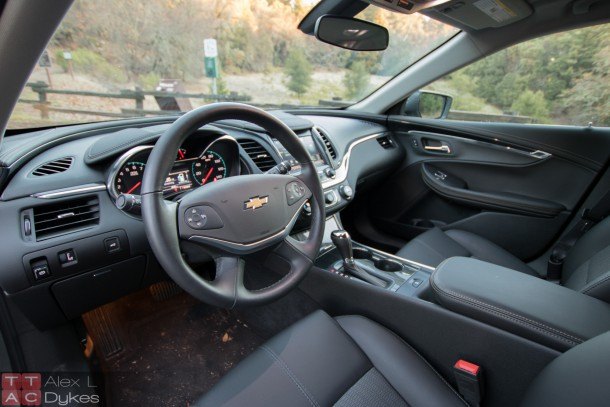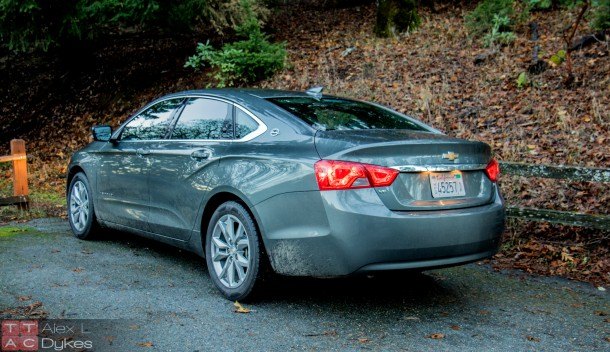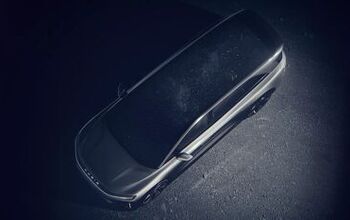2016 Chevrolet Impala Review - Buick's Second Fiddle (Video)

2016 Chevrolet Impala 2LT
The Impala exists in an odd segment of its own. The full-sized Chevy is one of the largest sedans on sale in America, yet its base engine is only a 2.5-liter four cylinder. Based on the pricing and feature options, the Impala is designed to be a semi-step above the Malibu, yet the number of true competitors the Impala has is extremely small. That’s because GM’s philosophy in the large sedan segment is different from the rest. Most of its competitors have two entries in this segment: one mass-market option and one luxury option. GM, however, slices its pie three ways with the Chevy Impala, Buick LaCrosse and Cadillac XTS.
That puts the Impala in the dubious position of the least expensive option in GM’s full-sized portfolio. It also means the Impala’s full-sized competition narrows to just the Taurus and the Charger. Why? Because the real competitor to the Chrysler 300, Hyundai Azera, Kia Cadenza, Acura RLX and most trims of the Toyota Avalon isn’t the Impala, but the Buick LaCrosse. Meanwhile, top-end trims of the RLX, Cadenza, Azera, Chrysler 300 and Lexus ES cross shop with the Cadillac.
Has GM sliced things just a little bit too fine with the Impala? Let’s find out.
Exterior
The current LaCrosse is a hair too bubbly and the XTS’s proportions seem awkward thanks to the Caddy being longer but not wider than the others. For the Impala, Chevy borrowed cues from Cadillac’s Art and Science theme and a bit of last-generation Camaro when crafting the angular and aggressive front end. The look is more exciting than the Avalon and Taurus, and just a hair behind the Charger’s new nose in my book.
Sadly, it seems the sheetmetal budget was spent by the time designers got to the rear. Like many of Chevy’s crossovers, the Impala has a Plain Jane rear end with hidden exhaust tips and large flat surfaces. That said, the Impala has aged better than I thought it would since it was redesigned, and I’d place it just behind the refreshed Chrysler 300 in the aesthetics department.
It may not be obvious in pictures, but the Impala is big. Really big. At 201.3-inches long, this Chevy is 3-inches longer than the Dodge Charger and a full foot longer than a Toyota Camry. Unlike the discontinued Chevrolet SS or the large Chryslers, the Impala is a front-wheel-drive sedan with unmistakable front-wheel-drive proportions. The low front end, short hood and long passenger compartment may not be as imposing as the Chrysler 300’s muscle car profile, but it translates directly to an enormous cabin.
Interior
The center air vents and their housings are oversized and cast out of a plastic that doesn’t match anything other than the similarly large and questionable plastic part around the climate control. What makes the quality of these parts vexing is not the parts themselves, but the fact that everything else in the Impala’s cabin is executed with a high level of polish. The stitched instrument cluster cover and trim over the infotainment system are perfect. The steering wheel feels substantial and reminiscent of the last Mercedes S-Class. The door panels are well trimmed in soft plastic. Overall, there’s less hard plastic in this cabin than in a Camcord. The average component in this cabin feels more luxurious than the Dodge Charger or the Ford Taurus. The trouble for Chevy is those cars do a better job of keeping the cheaper bits away from your reach, whereas the Impala shines a spotlight on them.
Redeeming the Impala is an interior that’s enormous. The front seats are large and comfortable, coming in just below the top-end seats in the LaCrosse, Cadenza and Taurus, which is impressive since you have to pay considerably more for the top-end thrones in those models. Sadly, GM decided to remove four-way power lumbar support in the redesigned Impala, but these seats still top the Charger and 300 in general comfort.
Although the Impala isn’t a great deal wider than your average Camcord, it’s notably longer. That’s obvious in the back seat where you find more than 5 inches of additional legroom versus the Camry. The astute among you may notice this doesn’t show up in the spec sheet as you’d expect. When considering legroom, it’s important to look at combined legroom (front plus rear) as well as the front and rear numbers individually to get a complete picture. The Impala’s front seats offer a wide range of motion and accommodate taller drivers with ease. Moving the seats to a position that’s comfortable for my six-foot frame (so my feet are on the floorboards) results in limo-like room in the back. In fact, the Impala’s total legroom figures are just 2/10ths of an inch behind the recently stretched BMW 7-Series.
Although GM’s engineers honestly wasted a great deal of room by using tubular hinges and squaring off the cargo area so the hinges don’t interfere with your cargo loading, the Impala will still hold 18.8 cubic feet of your stuff in the trunk. That beats most entries with the exception of the Taurus that uses “hidden hinges” to swallow an additional 1.3 cubic feet.
Infotainment
The software used in the Impala is based on Cadillac CUE, with a few changes to separate the rabble from the upper crust. The XTS’s system features a capacitive touchscreen like your iPad or Android tablet, while the Chevy system makes do with a resistive touchscreen like your old Palm Pilot. The proximity sensor is also removed in the name of cost savings. Thankfully, the touchscreen itself is the only real wrinkle. The software is much snappier and more reliable than when it launched. The optional navigation interface still seems a little old school, but the input method is now more natural and allows you to just type in “123 Main St Brisbane California.” The system will decipher your meaning and give you options based on your input.
Also notably different since the last time we sampled this system is Apple CarPlay integration. (Android Auto will be available via a software update in March.) This makes the Impala and its Buick sistership the first full-sized sedans to offer this new level of smartphone integration. All models with the 8-inch LCD get the feature and the more I use it, the more I like the concept. Instead of paying extra for the full navigation software that I don’t find terribly attractive, you just use what’s on your phone already. GM also bundles OnStar with the Impala, as it does with all of its cars these days, and you can use the OnStar-served turn-by-turn directions if you so choose.
Drivetrain
New for 2016 is a 3.6-liter V-6 engine capable of running off either compressed natural gas or gasoline via a twin-tank setup. The gasoline tank is in the usual place delivering over 300 miles of range, while the CNG cylinder occupies nearly half the trunk and is good for 150 miles.
Before you get too excited, you should keep a few things in mind.
First, it won’t qualify for California’s HOV stickers like Honda’s CNG Civic. Second, it’s 23-percent more expensive than the standard 3.6-liter V-6. And lastly, output drops from 305 horsepower to 260 when running on gasoline and sinks an additional 30 horsepower further on CNG. Torque drops similarly from 264 lbs-ft to 247 or 218 depending on the fuel.
Drive
While GM still needs to fine tune the Impala’s interior, they really know how to design a front-wheel-drive suspension. Handling is excellent even without the Hi-Per Strut suspension that is optional in the Buick and standard in the Cadillac. Aided by standard 235 width tires, the Impala will eat up your favorite winding mountain road with greater enthusiasm than your average midsize sedan. Many shoppers seem to be under the impression that jumping from a Camcord-sized car to a Taurus/Impala sized sedan would result in poorer handling, but that’s not the case. Thanks to the lighter curb weight and tires that are two-sizes larger than the base Dodge Charger, the Impala out handles the price-comparable Dodge. To top it all off, we averaged a very similar 22 mpg in mixed driving, even though the Impala has wider tires and two fewer gears than the Charger.
Pricing
Because Chevy isn’t supposed to step on Buick’s toes too heavily, the Impala tops out at around $40,000 and doesn’t offer the fancy front suspension, optional all-wheel drive or the mild hybrid. But the Impala’s real problem can be seen in the comparison to the LaCrosse. The Impala ends up more expensive than the competition when configured comparably, but the LaCrosse ends up being one of the best deals. If you want the V-6 (and trust me, you do), the Buick is just $630 more expensive. Piling on, the Buick includes $1,500 more standard equipment — such as an 8-inch LCD instrument cluster, power passenger seat, and auto dimming mirrors (among others) — and makes the Buick effectively less expensive than the Chevy. If that’s not enough, the Buick offers a slightly more premium brand and a longer warranty.
A serious redesign is coming to the LaCrosse for 2017, and possibly some updates to the Impala, as well. However, I’m not sure they will improve much for the Chevy. The 2017 Buick LaCrosse will be adding a more refined cabin, refreshed exterior and GM’s new eight-speed automatic, which should improve both fuel economy and acceleration. And yet most experts seem to agree that the LaCrosse’s price tag is only going to grow by a small amount. Considering the major upgrades to the Buick, the value proposition of the Impala could actually get worse.
After a week with the Impala, I started to question its existence. It’s not that the Impala is a bad car on its own. It’s that Chevy’s full-sized sedan doesn’t exist in a vacuum. If the Impala’s price tag started midway between the Malibu and the LaCrosse, it’d be a steal. As it is, however, the Impala is often sitting on the same lot as the LaCrosse, which offers more refinement, more comfort, better handling, a longer warranty for $630 bucks and a trunk that’s a few cubes smaller — and that’s in the LaCrosse’s current form. Until GM adjusts the Impala’s MSRP down $5,000 or goes back to a simple badge engineered LaPala, the Chevy is destined to play second fiddle to its Buick cousin.
GM provided the vehicle, insurance and one tank of gas for this review
Specifications as tested
0-30 mph: 2.4 seconds
0-60 mph: 6.0 seconds
1/4 mile: 14.6 seconds @ 95 mph

More by Alex L. Dykes
Latest Car Reviews
Read moreLatest Product Reviews
Read moreRecent Comments
- Jeff I doubt most people care. Care more about their vehicles but after being a loyal gm customer for almost 50 years and having family members all the way back to my grandparents I no longer care. The last gm vehicle I owned was 2 years ago. To me gm can go into the dustbin of history.
- Cprescott I'm surprised they didn't move to China. That is who bankrolled their bankruptcy bailout plan.
- Analoggrotto You ask as if I should care. Well I don't. Any more questions?
- Analoggrotto What the heck are those people doing in front of that house? Just staring at this stupid pos truck?
- Jeff Good review but the XLT although not a luxury interior is still a nice place to be. The seats are comfortable and there is plenty of headroom. The main downside is the limited availability resulting in dealer markups above MSRP. I have a 2022 hybrid Maverick XLT for over 2 years and it has more than met my expectations. I believe for many who do not need a truck most of the time but want one the Maverick will meet most of their needs.






































































Comments
Join the conversation
I have driven Impala over the years across country. Great traveling auto even with four adults. Large Trunk. Good gas mileage. If you want a large auto... Impala is the auto to buy. I did not have any problems with ones I owned. GM did a good job on this one.
My last 2 Impalas a 2000 and a 2008, have been very good cars with a minimum of issues. The 2000 needed it's intermediate shaft lubricated twice at 50 bucks for each visit and the upper intake was swapped out for a Dorman upgrade at 120K miles. Other than that it was just routine service. Kept that one until 172K miles and traded it on a 2008 Impala 2LT 3900. That was a really good car and a noticeable improvement over the 2000. The only replaced items were a battery and alternator at 110K. Traded that one in on a 2013 red jewel LT which I currently have. It now is nearing 50k miles with zero problems but a couple of noticeable things. The 3.6 is actually less refined when cold than the 3800 or 3900 in my other cars and is a little rough and ragged at cold idle. It settles down and runs smoothly thereafter. A fresh oil change seems to smooth things out a bit but it has been noted many times that the LFX is a bit rough around the edges when cold and idle. The other thing is the 6 speed auto which 99% of the time shifts clean and smooth until you gas it up and quickly change your mind and lift off the go pedal. It then acts slow and funky sometimes taking up to 5 seconds to up-shift. The old 4 speeds never did that but I have come to the realization that many of these new 6-9 speed automatics in today's vehicles take some getting used to and aren't quite as polished as the older 4 speed trans axles. When asked if I would buy another Impala of this new generation the answer is a solid yes.